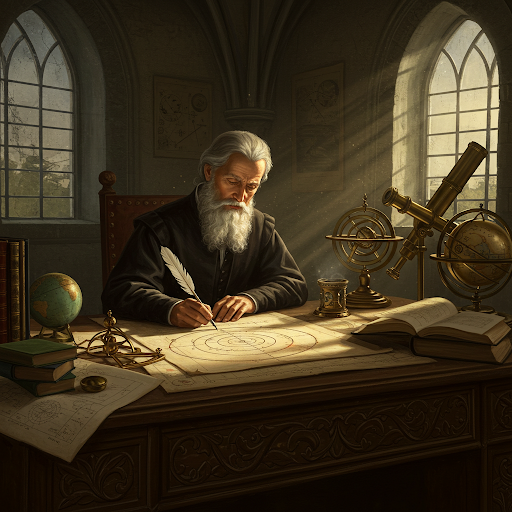Harmony of the Worlds: Celestial Music and the Divine Order
1609, Prague. A dimly lit study, filled with the scent of parchment and the hum of celestial calculations.
Dust motes dance in the shafts of sunlight filtering through the grimy windows. Instruments of observation — a brass astrolabe, a worn telescope, and a collection of meticulously crafted models of the solar system — lie scattered across the desk.
Kepler, his face illuminated by the flickering light of a candle, traces elliptical orbits on a sheet of parchment. “Observe,” he whispers, his voice a low murmur, “the planets do not move in perfect circles, but in ellipses, the Sun at one focus.” He points to a complex diagram, where musical notes seem to correspond to the planetary movements. “The cosmos is a symphony,” he declares, “a celestial ballet governed by divine harmony.” You notice a manuscript titled “Harmonices Mundi,” filled with intricate musical notations and astronomical observations.
A faint, ethereal hum emanates from the orrery, and you hear Kepler whisper, “The divine hand is evident in the mathematical perfection of the heavens.” A fragment of papyrus lies near the manuscript, bearing the inscription: “Seek the harmony in the chaos, the music in the spheres, and the divine order in the cosmos.”
The planets orbit the Sun in elliptical paths, governed by divine harmony and mathematical laws.

The orrery begins to spin, its gears whirring in time with an ethereal melody: “Unravel the celestial music and discover the harmony of the spheres.”
While Kepler’s work charted the precise movements of celestial bodies, laying the foundation for our understanding of cosmic mechanics, the inquiries of Robert Boyle delved into the very nature of matter itself. Boyle’s experiments with gases revealed fundamental relationships between pressure, volume, and temperature, paving the way for modern chemistry and a deeper understanding of the physical world at a more tangible level.
